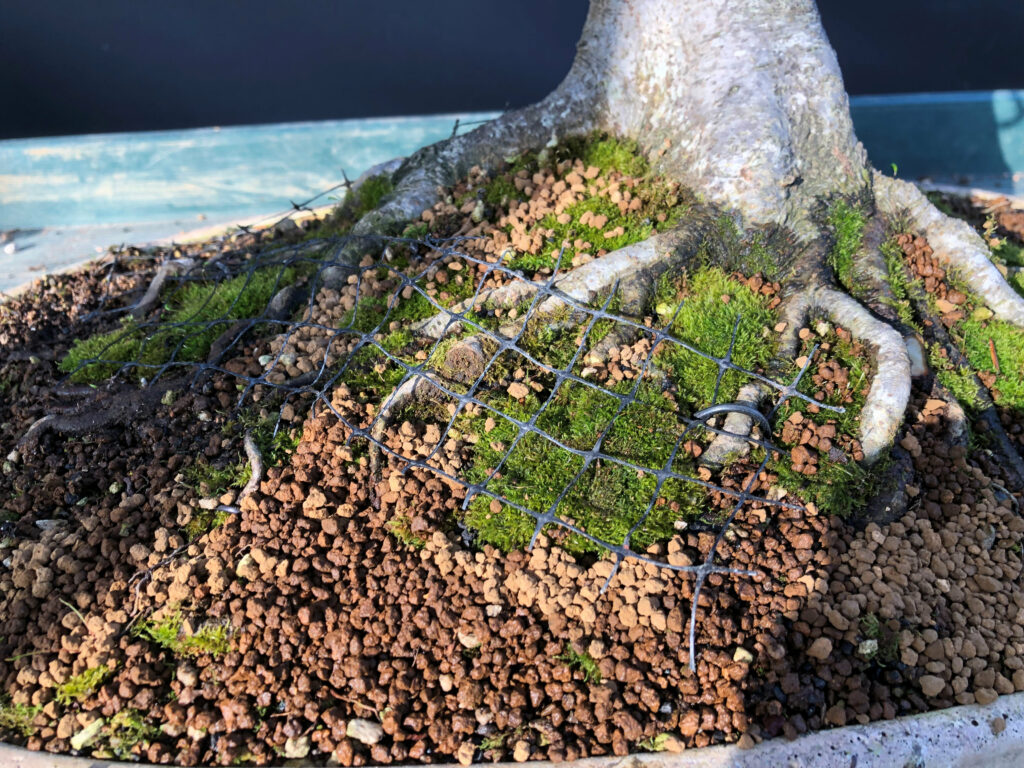
There is no need to resort to thick, tightly-woven green netting over the surface of your bonsai, it looks awful and is overkill!
One major irritation for many bonsai enthusiasts is the discovery of the carefully placed mosses on their bonsai, and soil surface in general, having been scattered around the display benches, and surrounding areas.
The mosses and soil surface is returned to normal, the benches cleaned up. Only for the same destruction of carefully prepared roots, soil and mosses to be made the following day. This damage can continue for weeks, on an almost daily basis and has been known to drive bonsai enthusiasts to despair!.
The culprits can sometimes be pigeons, or occasionally squirrels (although I have yet to encounter any major problem with either). However, my experience of growing bonsai in a number of gardens around the UK has been that the persistent and highly annoying problem is exclusively caused by blackbirds.
Blackbirds have a feeding habit that requires them to forage through soil, under moss and dead leaves in pursuit of food. As a relatively strong bird, they are able to toss aside any ‘debris’ they find in a bonsai pot leaving a trail of mess around the edges. Young blackbirds are even less delicate and I have even witnessed them trying to drag young roots out of the soil in the mistaken belief that they are worms……….
Using Netting to Protect the Soil and Moss
The most effective way of stopping the damage that Blackbirds, squirrels and other pests cause is the use of netting over the soil surface.
However, I often see images of enthusiasts entire collection covered in thick, tightly-woven green netting and that just ruins the appearance of their trees.
It is not necessary to have netting that is too fine for a bird to peck through it. A loose-weave, almost invisible net is more than sufficient.
I have found that although the loose-weave net can’t ‘block’ a bird from your moss, it completely stops the damn thing even landing on the foot of the tree. I suspect, for fear of getting caught up in the netting.

A few strips of loose-weave netting over the mossed areas of this Beech bonsai, held down with a few staples made from bonsai wire. This maybe all that is needed. If the pest returns, just add some more.
Stopping Blackbirds from Damaging Your Bonsai
Blackbirds tend to leave domestic gardens alone during the Summer and early Autumn but as the Winter approaches, they start to frequent the relative safety of our gardens. As very territorial birds, there will be just one male blackbird (jet-black in colour) that dominates in your garden; as Winter ends the male blackbird will begin mating and as the first young begin to hatch in February/March, the amount of destruction to your bonsai can increase significantly.
Blackbirds are habitual feeders and you will notice that they will visit a number of specific places in your garden on an almost twice-daily basis, at dawn and then at dusk. As soon as I become aware that a blackbird has started causing damage to the soil surface of my bonsai, I will apply the net to any trees that are visited. This instantly stops my bonsai being as attractive to the birds and less likely to become part of the birds’ regular feeding pattern.

By the time the tree is placed back in the garden, the netting is barely noticeable. I’ve found that even if over the course of the year, the moss grows up and around the net, it is still a significant deterrent and almost vanishes from sight.
Strong Odours, Plastic Hawks and Other Methods.
Removing the moss will go a long way to stop blackbirds being initially attracted to your bonsai. However, the best physical deterrent for stopping the birds from actually damaging the soil is through the use of strong odours.
It appears that Blackbirds have quite a keen sense of smell and I have realised over the years that Blackbirds dislike trees that have an ‘odour’. I regularly use a product called Jeyes fluid around the surrounding benches liberally, leaving something of an odour around my trees (of disinfectant).
After spraying with Jeyes Fluid I find that most Blackbirds will avoid the area…for a while!
Once the area has been sprayed repeatedly for a number of weeks, the blackbird seems to ‘learn’ that the soil and surrounding areas smell repellent to them, are not areas where edible food is found and they stop visiting them altogether.
Alternatives to Armillatox that I have used over the years include a much diluted mix of lime-sulphur solution, Tabasco pepper sauce with water, and soluble cat- and dog-repellents. All of which work to varying degrees and for varying amounts of time.
Another tactic that I have used (and still use) are a pair of plastic hawks, purchased cheaply online and placed in the garden. They are fairly effective against pigeons and blackbirds and it does seem to make them fairly nervous of coming into the garden.
Our Online Shop is owned and run by bonsai artist and author Harry Harrington..
For bonsai supplies, soils, books, tools and bonsai for sale!





